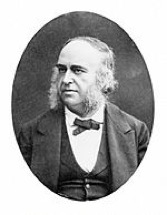Pierre Paul Broca
kj-sa
Broca is most famous for his discovery of the speech production center of the brain located in the ventroposterior region of the frontal lobes (now known as Broca's area). He arrived at this discovery by studying the brains of aphasic patients. His first patient in the Bicêtre Hospital was Leborgne, nicknamed "Tan" due to his inability to clearly speak any words other than "tan".
In 1861, through post-mortem autopsy, Broca determined that Tan had a lesion caused by syphilis in the left cerebral hemisphere. This lesion was determined to cover the area of the brain important for speech production, affecting syntactic skills of patients. (Although history credits this discovery to Broca, another French neurologist, Marc Dax, made similar observations a generation earlier.) Today the brains of many of Broca's aphasic patients are still preserved in the Musée Dupuytren, and his collection of casts in the Musée d'Anatomie Delmas-Orfila-Rouvière. Broca presented his findings on the localisation of language at the 1868 British Association meeting in Norwich, chaired by Joseph Dalton Hooker, and the subsequent discussions included Hughlings Jackson.
Patients with damage to Broca's area and/or to neighboring regions of the left inferior frontal lobe are often categorized clinically as having Broca's aphasia. This type of aphasia, which often involves impairments in speech output, can be contrasted with Wernicke's aphasia, named for Karl Wernicke, which is characterized by damage to more posterior regions of the left hemisphere (in the superior temporal lobe), causing semantic disruptions within the output of speech. This is an example of a double dissociation, an important tool used by neuropsychologists to investigate brain function.




